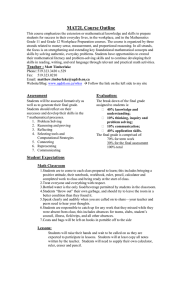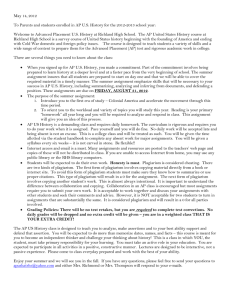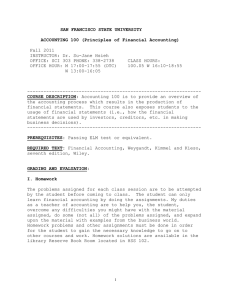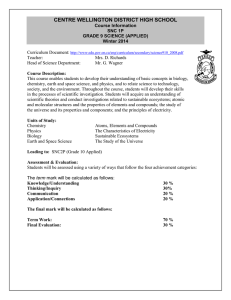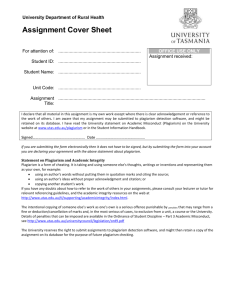MAT 1L Course Outline – Essential Math 9
advertisement
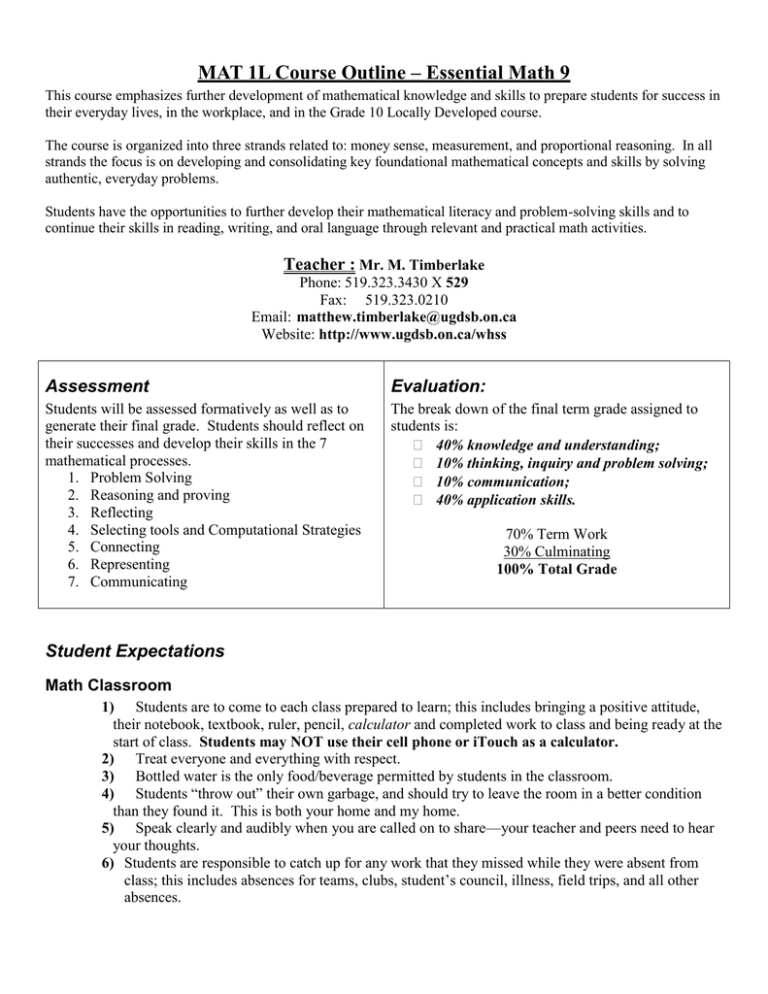
MAT 1L Course Outline – Essential Math 9 This course emphasizes further development of mathematical knowledge and skills to prepare students for success in their everyday lives, in the workplace, and in the Grade 10 Locally Developed course. The course is organized into three strands related to: money sense, measurement, and proportional reasoning. In all strands the focus is on developing and consolidating key foundational mathematical concepts and skills by solving authentic, everyday problems. Students have the opportunities to further develop their mathematical literacy and problem-solving skills and to continue their skills in reading, writing, and oral language through relevant and practical math activities. Teacher : Mr. M. Timberlake Phone: 519.323.3430 X 529 Fax: 519.323.0210 Email: matthew.timberlake@ugdsb.on.ca Website: http://www.ugdsb.on.ca/whss Assessment Evaluation: Students will be assessed formatively as well as to generate their final grade. Students should reflect on their successes and develop their skills in the 7 mathematical processes. 1. Problem Solving 2. Reasoning and proving 3. Reflecting 4. Selecting tools and Computational Strategies 5. Connecting 6. Representing 7. Communicating The break down of the final term grade assigned to students is: 40% knowledge and understanding; 10% thinking, inquiry and problem solving; 10% communication; 40% application skills. 70% Term Work 30% Culminating 100% Total Grade Student Expectations Math Classroom 1) Students are to come to each class prepared to learn; this includes bringing a positive attitude, their notebook, textbook, ruler, pencil, calculator and completed work to class and being ready at the start of class. Students may NOT use their cell phone or iTouch as a calculator. 2) Treat everyone and everything with respect. 3) Bottled water is the only food/beverage permitted by students in the classroom. 4) Students “throw out” their own garbage, and should try to leave the room in a better condition than they found it. This is both your home and my home. 5) Speak clearly and audibly when you are called on to share—your teacher and peers need to hear your thoughts. 6) Students are responsible to catch up for any work that they missed while they were absent from class; this includes absences for teams, clubs, student’s council, illness, field trips, and all other absences. Lessons: Students will raise their hands and wait to be called on as they are expected to participate in lessons. Students will at least copy all notes written by the teacher. Students will need to supply their own calculator, ruler, eraser and pencil. Work Periods: Students will work quietly and independently during work periods, but remember that teachers and assistants are here to help! If you need help, ASK! Although I will patrol around, I am not a mind-reader (not yet, at least)…you need to be open and honest if you are having trouble. There are many ways to explain things…I can guarantee that I can teach you any concept in this course! Assigned work: Each day you will have an opportunity to finish work in class. There may be times when you will have more work than time. You are responsible to have it completed before the next class, even if you are absent (get a study buddy, make advanced arrangements, phone/email, etc). Completed Work: Students should attempt assigned questions, and present a clear solution to these questions in their work books. Students should then verify the bottom line of their solution with the answers posted or taken up in class. If a student finds that they are “wrong” in less than 10% of those questions then the student should ask about those questions at the start of next class. If a student finds many of their answers are “wrong” then the student should seek extra help outside of classroom time. Assessments: Quizzes and tests require that students communicate in absolutely NO WAY, (i.e. no talking, tapping in code, passing rulers, passing calculators, passing pencils etc.) When work is assigned to be handed in, students are expected to be the original authors of the work that they hand in, (i.e. no copying). Refer to plagiarism policy in your student agenda. Due Dates: Assignments are to be completed and submitted in a reasonable amount of time, (determined by the teacher). Any assignment that is submitted after a due date is a “late assignment”. Late assignments will be accepted, but students may be at risk of losing valuable marks. Students with late assignments may also be assigned to the Student Success room, or may have to come in before or after school, or at lunch. Once a solution set has been presented to a class the grade can only be pass/fail. Plagiarism: Wellington Heights Secondary School has a rigid plagiarism policy outlined in your student handbook. In mathematics students need to be extra careful that the work they submit is their own. Plagiarism includes copying, (from a book, the internet, a journal, a peer’s solution, etc) and submitting it as your own. Plagiarism also includes getting help, (from a teacher, peer, friend, tutor, etc) and submitting your solution without actually understanding it; in this case the fault is not in getting the help, the fault is in submitting your work as being your thoughts when those thoughts are not actually your own. A good guide for you to use when you submit your work is that you should be able to sit alone and produce a solution without copying from any source, (even your earlier draft). Extra Help: I am able to provide extra help with course material before or after school, or at lunch. Please let me know ahead of time, and we’ll set something up. The Math Help Room is also available Monday through Thursday at lunch for extra help. (please sign and return to teacher) Dear Parents, Your son/daughter is enrolled in Essentials Mathematics 9, and I hope that you have had the time to review this course outline with them. I hope that you will encourage your son or daughter to follow these guidelines to the best of their ability, and be supportive as they progress through this course. I have also given your son/daughter a handout that describes tips for parents to help improve the chances of their children doing well in Mathematics. Your son or daughter will also be given a workbook. The serial number and condition have been noted. From here, two options are available: 1. (Recommended): Students can purchase the workbook for a cost of $20.00, and may complete practice and homework by writing directly in the book. Cash or Cheques (made out to WHSS Math Department) may be paid to the teacher. 2. Students must write practice questions out on loose leaf paper and return the workbook at the end of the semester with no marks in the book whatsoever. If any marks are made, then the student/parent will be responsible for the above replacement cost. Finally, I would like to keep in contact with as many parents as possible. The easiest method for me is e-mail (matthew.timberlake@ugdsb.on.ca); however, I am always available by phone (519-323-3430, x.529). I would also like to request your contact information. It will allow me to pass on messages of upcoming tests (in the form of a mass e-mail), missing assignments, and most importantly…praise! A course website is also available: www.ugdsb.on.ca/whss (look for my name on the left side) -On the website, I hope to post important dates, electronic copies of handouts, etc. I have read the introductory pages and will follow them to the best of my ability. ____________________________________ _____________________________________ Student Print Name Student Signature I have read the introductory pages and will encourage my son/daughter to follow the guidelines to the best of their ability. ____________________________________ _____________________________________ Print Name (Parent/Guardian) Signature (Parent/Guardian) Parent Contact Information: E-mail: ______________________________________________ Phone Number: _____________________________________________
